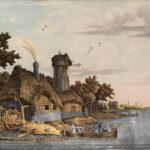Plot and Storyline
Lewis Carroll wrote the fantastic novel Through the Looking Glass, which he released in 1871 as a follow-up to his earlier work, Alice’s Adventures in Wonderland. The story follows the adventures of a young girl named Alice as she steps through a mirror into a magical world on the other side.
The novel begins with Alice sitting in her home, bored and restless. She notices a mirror that seems to be reflecting a different room, and curious as ever, she steps through it. On the other side, Alice finds herself in a world where everything is reversed. She encounters peculiar characters such as talking flowers, a Red Queen, a White Queen, and various anthropomorphic creatures.
Throughout her journey, Alice experiences a series of nonsensical and bizarre events. She becomes a pawn in a giant chess game, where she must navigate the squares and interact with the chess pieces that come to life. As she progresses through the chessboard, she meets characters like Tweedledum and Tweedledee, Humpty Dumpty, and the White Knight, each offering her their own peculiar wisdom and riddles.
As Alice moves closer to becoming a queen herself, she encounters challenges and obstacles that test her wit and courage. She learns the importance of logic and reasoning in this topsy-turvy world, where things often defy conventional understanding. Eventually, Alice reaches the final square and becomes a queen, only to wake up from her dream and find herself back in the real world.
Characters
Through the Looking Glass features a range of colorful and eccentric characters. Alice, the protagonist, is a curious, imaginative young girl who serves as the reader’s guide through this surreal world. She undergoes personal growth and development as she navigates the challenges presented to her and learns to think critically in unfamiliar situations.
The Red Queen and the White Queen symbolize different aspects of authority and power. The Red Queen is domineering and assertive, while the White Queen is gentle and absent-minded. Their contrasting personalities highlight different approaches to leadership and influence.
Other memorable characters include the Cheshire Cat, a mischievous feline with a penchant for riddles and enigmatic advice; the Mad Hatter and the March Hare, who perpetually host a tea party stuck at six o’clock; and the Tweedle brothers, who engage Alice in philosophical debates and nonsensical wordplay.
Themes and Symbols
Through the Looking Glass explores several themes and employs various symbols to convey its message. One prevalent theme is the fluidity of identity and the exploration of self. Alice’s experiences in the mirror world challenge her understanding of herself and force her to question who she is and how she perceives reality.
Another significant theme is the power of language and communication. Carroll employs wordplay, puns, and linguistic puzzles throughout the novel to emphasize the importance of effective communication and the limitations of language. The characters’ unconventional use of language reflects the nonsensical nature of the world Alice finds herself in.
The concept of time is also explored in the novel. Time is personified as a character who scolds Alice for her inability to comprehend the fluidity of time in Wonderland. This symbolizes the human struggle to grasp the abstract concept of time and highlights Carroll’s fascination with the subject.
Writing Style
Lewis Carroll’s writing style in Through the Looking-Glass is whimsical, imaginative, and filled with linguistic playfulness. He creates a dreamlike atmosphere through his use of vivid descriptions and fantastical imagery. Carroll’s language is often poetic, employing rhythmic patterns and playful rhymes that add to the otherworldly ambiance.
Carroll’s narrative structure follows a loose episodic pattern, with Alice encountering different characters and situations in each chapter. His use of dialogue and witty banter between characters adds depth and humor to the story. Carroll’s writing style enhances the reader’s experience by immersing them in a world where logic and reality are constantly challenged.
Setting and Atmosphere
The setting of Through the Looking Glass is primarily the mirror world, which reflects a distorted version of reality. This alternate reality is characterized by its nonsensical nature, where the laws of physics and logic do not apply. The mirror serves as a metaphorical gateway into a land of imagination, where anything is possible.
The atmosphere of the novel is whimsical and surreal, with a sense of constant movement and transformation. The ever-changing landscape, the peculiar characters, and the illogical events contribute to an atmosphere of wonder and confusion. The setting and atmosphere work together to create a sense of enchantment and transport the reader into Alice’s extraordinary journey.
Historical, Social, or Political Context
Through the Looking Glass was written during the Victorian era, a period marked by significant social and cultural changes. Carroll’s novel can be seen as a critique of the rigid social norms and expectations of the time. The nonsensical world of Wonderland can be interpreted as a satirical representation of strict Victorian society, where conformity and propriety were valued above individuality and creativity.
Carroll’s work also reflects the influence of the mathematical and logical theories of the time. The concept of a chessboard and the use of logical puzzles and riddles throughout the novel reflect Carroll’s interest in mathematics and logic. The novel can be seen as a playful exploration of these concepts and a commentary on the limitations of logical reasoning.
Impact and Reception
Through the Looking Glass has had a lasting impact on literature and popular culture. It has become a beloved classic, captivating readers of all ages with its imaginative world and memorable characters. The novel’s influence can be seen in various adaptations, including stage plays, films, and even video games.
Carroll’s novel has been praised for its creativity, wit, and ability to transport readers into a world of fantasy. It has been recognized for its literary merits and its contribution to the genre of children’s literature. Through the Looking Glass continues to be studied and analyzed by scholars, who explore its themes, symbolism, and literary techniques.
How does Lewis Carroll’s Through the Looking Glass challenge traditional notions of reality and identity?
Through the Looking Glass challenges traditional notions of reality and identity by presenting a topsy-turvy world where logic and conventional understanding are constantly undermined. The novel introduces readers to a mirror world that reflects a distorted version of reality, inviting them to question their own perceptions and assumptions.
In this mirror world, Alice encounters a series of nonsensical events and characters that defy logic. The reversal of familiar elements, such as the Red Queen’s ability to run faster but stay in the same place, challenges the reader’s understanding of cause and effect. The novel’s playful language and linguistic puzzles further blur the boundaries between meaning and nonsense, inviting readers to question the limitations of language and communication.
Alice’s journey through the mirror also raises questions about identity. As she navigates the chessboard and interacts with the chess pieces, she experiences a transformation from a pawn to a queen. This journey symbolizes a metaphorical exploration of self and the fluidity of identity. Alice questions her own identity and the nature of who she is in this fantastical world, highlighting the malleability and subjective nature of identity itself.
Furthermore, the characters Alice encounters in the mirror world often display fragmented or inconsistent personalities. The Cheshire Cat, for example, can disappear and reappear at will, representing the elusive and ever-changing nature of identity. The Mad Hatter and the March Hare, perpetually stuck at six o’clock, challenge the concept of fixed time and the rigidity of societal norms.
Through these narrative devices, Lewis Carroll challenges the reader to question their preconceived notions of reality and identity. By presenting a world where logic and rationality are disrupted, Carroll encourages readers to embrace imagination and unconventional thinking. The novel’s exploration of the fluidity of identity suggests that one’s sense of self is not fixed but rather a product of personal growth and the context in which one exists.
In this way, Through the Looking Glass invites readers to consider that reality and identity are not absolute, but rather subjective constructs that can be shaped and reimagined. By challenging traditional notions of reality and identity, Carroll encourages readers to embrace the power of imagination and the possibility of alternative perspectives.
Final Conclusions
Through the Looking Glass is a whimsical and enchanting journey into a topsy-turvy world where logic and imagination collide. Lewis Carroll’s imaginative storytelling, playful language, and memorable characters have captivated readers for generations. The novel explores themes of identity, language, and the nature of reality, inviting readers to question and challenge their own understanding of the world.
Carroll’s writing style, characterized by its poetic language and linguistic playfulness, enhances the reader’s experience and immerses them in the surreal atmosphere of Wonderland. The novel’s setting and atmosphere contribute to its dreamlike quality, creating a sense of wonder and enchantment.
Through the Looking Glass reflects the historical and social context of the Victorian era, critiquing the rigid social norms and emphasizing the importance of individuality and creativity. Its impact on literature and popular culture is undeniable, with its enduring legacy as a beloved classic and its influence on subsequent works.
In conclusion, Through the Looking Glass is a timeless masterpiece that continues to delight and inspire readers of all ages. Its imaginative storytelling, thought-provoking themes, and whimsical characters make it a must-read for anyone seeking an adventure into the realm of imagination.
Sources
Through the Looking-Glass – Wikipedia
Through the Looking-Glass: Study Guide | SparkNotes
Through the Looking-Glass by Lewis Carroll | Project Gutenberg






